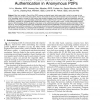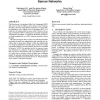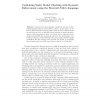270 search results - page 54 / 54 » Verifying Second-Level Security Protocols |
TPDS
2008
13 years 5 months ago
2008
Most trust models in Peer-to-Peer (P2P) systems are identity based, which means that in order for one peer to trust another, it needs to know the other peer's identity. Hence,...
MOBIHOC
2005
ACM
14 years 4 months ago
2005
ACM
With the advance of technology, Public Key Cryptography (PKC) will sooner or later be widely used in wireless sensor networks. Recently, it has been shown that the performance of ...
ICFEM
2009
Springer
13 years 12 months ago
2009
Springer
Internet protocols encapsulate a significant amount of state, making implementing the host software complex. In this paper, we define the Statecall Policy Language (SPL) which pr...
SPW
2004
Springer
13 years 10 months ago
2004
Springer
This note presents a new way of composing cryptographic primitives which makes some novel combinations possible. For example, one can do threshold decryption using standard block c...
EUROCRYPT
2006
Springer
13 years 9 months ago
2006
Springer
In this work we provide efficient distributed protocols for generating shares of random noise, secure against malicious participants. The purpose of the noise generation is to crea...



